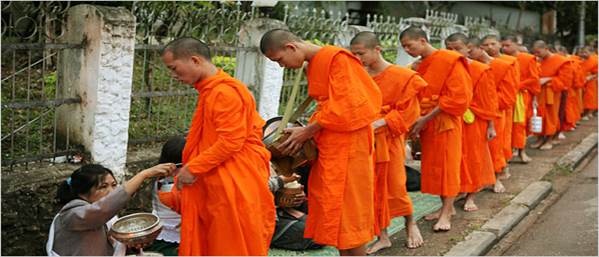3-8th November 2013 Luang Prabang, Laos Everyone is seduced by Luang Prabang. From the moment when Laos opened its doors to tourism in the 1980s, visitors have talked in reverent tones about the sleepy town far upcountry on the banks of the Mekong. It captivates. It weaves a spell. It carries some flavour of Indochina before the modern world got there. 

It has always been thus. Over a hundred years ago the explorer James McCarthy grew misty-eyed at the mere sight of its temple roofs from the Mekong. 'The pagodas' spires and gilded moulding glancing in the light of the setting sun,' he swooned, '…caused in me a feeling of irresistible melancholy.' Fifty years ago the American Harry Franck described it - perhaps just a little over the top - as one of the cities of Utopia. Thirty years ago Richard West quoted a Cambodian on the vanishing charms of Indochina: 'Luang Prabang is the last paradise left,' he said. West's concerns touch upon an anxiety about Luang Prabang - that it is vulnerable, that it cannot last forever. The town seems too fragile, too otherworldly, to survive the corrupting world of tourism. In visitors it provokes two responses. There are those who rave about it, and there are those who never mention it, for fear that others will go and spoil it. Set at the confluence of two rivers that almost surround the town, and beneath a temple-topped hill, Luang Prabang is a wonderful patchwork of traditional Lao wooden houses and hints of European architecture; reminders of when Laos was part of the French colony of Indochine. Golden-roofed wats, decorated with mosaics and murals of the life of Buddha, sit under the gaze of wrap-around teak balconies and 19th century shuttered windows. All of this is set against a backdrop of verdant greenery and rugged mountains. One of those small cities with atmospheric and charming personalities, Luang Prabang is now on the radar screen of most tourists who have been or dream of going to Venice, Salzburg, Dubrovnik, Ubod, Hoi An, Cuzco, San Miguel Allende, Guanajuato, Puebla, Morelia, Oaxaca, Napier, Santorini, or Santa Barbara. As a visitor, you cannot help but be amazed by the tidiness and cleanliness of perhaps the most charming city in all of Southeast Asia. With UNESCO so closely involved and a largely responsible group of local business owners, the pressures of mass tourism development have been held at bay, but for how much longer remains to be seen.    
Painting of Laotian dancer in traditional dress View from the dining room balcony of our hotel 
The restored and newer buildings along the small tributary of the Mekong 

Monks rowing across the Nam Khanto their temple Nam Khan, domain of the mythical naga. Ceremonies to appease the nagas and other evil spirits, and Buddhist religious practices (Prabang procession, the monks’ morning quest) perpetuate the sanctity of the place. Natural spaces located in the heart of the city and along the riverbanks, and wetlands (a complex network of ponds used for fish farming and vegetable growing) complement this preserved natural environment   
  
The Royal Palace is now a Museum to the Royal Family who lived there in the 1920’s – 1970.  
Our hotel offers the opportunity to watch a girl dancing to traditional music, and various costumes of the tribal Laotion people. We end each evening with coffee and after dinner drinks at another French pastry shop in the street, to take in the atmosphere of Luang Prabang at night. | 
